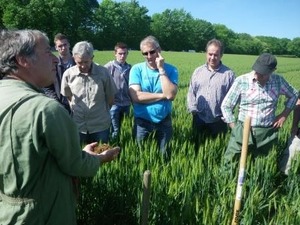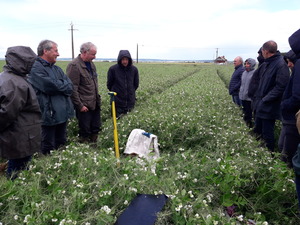Case study 14: France: Diversification of arable crops rotations, specialised on winter crops, under oceanic situations
Cluster 3: Crop diversification in systems from Western Europe
The case study has contributed to the development of low-input systems by improving weed management and soil fertility, maintaining economic margins and improving robustness in oceanic climate situations. Introduction of legumes in the crop sequence and intercropping seems to be efficient in reducing nitrogen use, energy consumption and greenhouse gas emission at the same time.



What were the main problems underlying the emergence of the case study?
Case study 14 addresses diversification of arable crop rotations for large-scale areas in France that are characterized by shallow and stony clay-limestone soils, subject to high water stress in late spring and summer. Rotations are generally short and based on winter crops only: winter oilseed rape, winter wheat and winter barley. Soil tillage is also often simplified due to the presence of stones. These cropping systems encounter typical problems such as low control of winter weeds (geranium, foxtail), insect damage (mainly on winter oilseed rape), resistance of pests to pesticides and yield stagnation or decrease over time.
How was the problem addressed and which actors were involved?
To address these problems, Terres Inovia has led a case study for about 10 years in central France (Berry), based on (i) a network of about 15 farmers wishing to be supported in the transition towards more robust and sustainable cropping systems and (ii) a field experiment (DiverIMPACTS field experiment 4) developing an innovative cropping system. Local partners (advisors of agricultural chambers or grain collectors and crop specialists from technical institutes) have been involved through the French project ‘Syppre’ (link to website below), and through DiverIMPACTS since 2017.
The vision for the case study shared by the farmers and the partners of the network is: ‘Through the exchange of experiences and continuous testing, evaluating and learning, farmers succeed in re-designing their cropping systems in way that is profitable, sustainable, and resilient. Based on fertile soil, the systems make it possible to obtain robust crops that express their yield potential and require few inputs’.
The mission of the case study was to support farmers by:
- encouraging the test of innovations on their farms;
- helping them observe their fields and evaluate the success of their cropping systems;
- facilitating the sharing of experiences among farmers and partners;
- introducing knowledge from the on-station cropping system experiment (see practice abstract below: Diversification in shallow soils)
Solution investigated
The main solutions investigated with farmers are:
- minimum tillage, permanent soil cover through cover crops, and introduction of legume crops to favour soil fertility
- lengthening and diversifying the rotations to disadvantage pests and weeds
- intercropping to mitigate pest damage, notably rapeseed with frost sensitive legume crops
In 2022, all the farmers have changed their cropping systems. Typical current cropping systems in shallow soils are based on a 5-6-year rotation and include a spring legume crop, often lentil and increasingly sunflower or millet. Problems of insect damage on rapeseed clearly decreased. Cereal yields have increased. Improving weed control and securing the success of legume crops remain challenges.
In addition to agronomic solutions, the case study developed innovative tools for the support approach of farmers. These include a dashboard that helps farmers analyse their success in relation to their objectives and make continuous improvements (more information see below).
Expected outcome
The case study has social, economic and technical expectations. The project will answer questions on how to scale out innovative cropping systems to farmers, involve collectors and promote emerging and new supply chains. The commercialization and competitiveness of new crops should be explored as well as specific technical advice on the production of sunflower and legume crops, and the efficient management of complex cropping systems.
Relevance to the DiverIMPACTS goals
This case study addresses situations with major problems from weed and insect damage, in which crop diversification can be a relevant solution but where the main barrier is agronomic with regards to the adaptation of diversification crops to shallow soils. The challenge is twofold: to find (i) the most robust diversification crops and (ii) the balance in the rotation between historical crops and diversification crops to obtain a sustainable system.
Case study legacy
The farmers of the network wished to continue the approach, despite the end of the DiverIMPACTS project and the retirement of Gilles Sauzet, the former case study leader. They would like to be supported in improving their control of cover crops and sunflower establishment, which is becoming an essential diversification crop for us. The farmers are also continuing to participate in the cropping system trial (field experiment 4), for example in workshops to redesign the innovative system in order to improve its performance.
Finally, the formalization of the support tools during the project was a way to ensure the legacy of the project by allowing their large-scale deployment. Terres Inovia now offers a training/tooling/supporting service for advisors to support farmers in their agroecological transition.
Further information
Links
- syppre.fr: Syppre website
- terresinovia.fr: Terres Innovia Tools
- zenodo.org: DiverIMPACTS Practice abstract: Developing tools that assist with design support approaches to promote cropping system diversification
- zenodo.org: DiverIMPACTS Practice abstract:Diversification in shallow soils: Learning from combining on-station experiment and on-farm support
Case study team
- Gilles Sauzet, Terres Inovia, case study co-leader
- Thibaut Pruvot, Terres Inovia, case study co-leader
- Stéphane Cadoux, Terres Inovia, case study monitor
 tap and then scroll down to the Add to Home Screen command.
tap and then scroll down to the Add to Home Screen command.